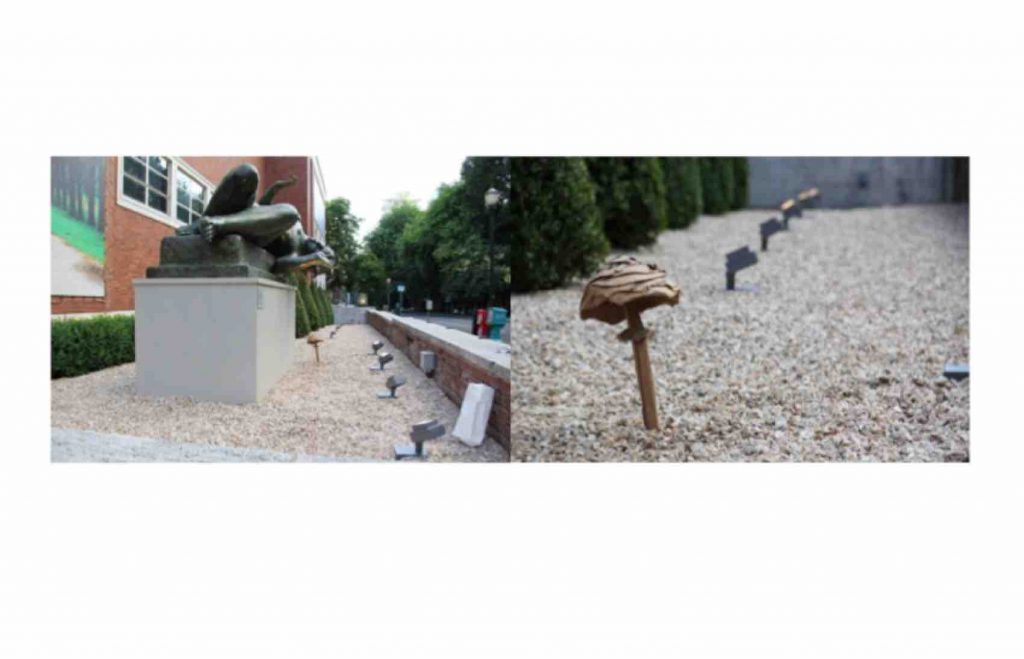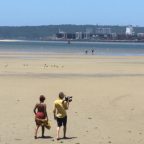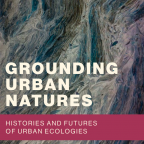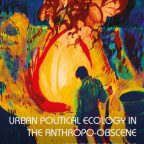Urban soils, artistic practice and Rancière. Writing from Portland, Oregon, Zbigniew Grabowski and Isaac Weiss invites us to an engaged art-science practice around urban sustainability. With a focus on urban soils they explore novel coordinates of how to do political ecological work in situated ways: “Through art in unexpected places we hope to stimulate a public appetite for paying attention to urban nature and to its needs.” For any questions or comments, please contact the authors.
*
MYCELIAL PERIGRINATIONS IN PORTLAND, OREGON
By Zbigniew Grabowski and Isaac Weiss
PROLOGUE
This project resulted from a collaborative natural science, social science and art practice approach at investigating, interrogating and engaging with urban soils and their remediation. It serves as a forum for a work in progress that lays out the theoretical underpinnings of an engaged art-science practice around urban sustainability. It also performs situated scholarly work on the major issues surrounding urban soils in Portland, OR in order to inform and inspire a series of open air installation pieces featuring reclaimed and recycled material sculptures. In particular, the work focuses on the seemingly invisible nature of urban soils, and contestations over the value of urban soils.
More radically, by borrowing from critical urban theory on alienation, politics and aesthetics, the project examines how soils and the ecological communities they support are marginalized, problematized and managed by human institutions. By focusing on using soil fungi as an artistic and scientific lens we ask what problems of separation between science, art and politics must we overcome to effectively communicate the plurality of values of urban soils? How are urban soils, fungi and an interventionist project related in their relationship to urban hegemony, cultural processes and practices of policing? How could we relate these philosophical, moral and aesthetic to the patterns and processes of urban formation? How have urban soils changed during the urbanization process in Portland? How has this led to particular narratives and situations of contamination? And what are the possibilities for a reinvigorated relationship between humans and urban soils through the restorative power of healthy fungal ecologies and their ecological communities? Rather than provide answers to these questions, we hope to stimulate discussion over them by presenting a narrative of urban transformation and exploration through a photo essay composed during an artistic-fungal intervention.
Enjoy!
EMBARKATION
We set out with this project to try to make the invisible visible. To clarify and draw out the hidden network of soil and mycelium that persist in the urban landscape permeated by a lattice of human designed, built and managed networks usually thought to typify the ‘urban’. A few difficulties arose. First, although fungus is everywhere, it’s very difficult to see or notice. We notice it most when it spoils our food, occupies the mechanical ventilation systems of our poorly designed buildings and blackens the shower caulk, but it doesn’t exactly announce itself quietly growing underneath the landscaping, in the mulch and under the blackberries in some forgotten strip of verge. We can’t wholly blame our senses, or lack thereof, for the invisibility of fungus. By nature fungus obscures itself, the majority of its life spent as microscopic hyphae; and yet its transient fruiting structures fill our imagination with what constitutes a mushroom. These fleshy growths facilitate collection and the dispersal of spores, and yet they are just passing emergences from an invisible subsurface network of single cell width fibers moving energy, nutrients and genetic material throughout the soil while stabilizing heavy metals, digesting organic pollutants and retaining water.
Secondly, our human relationships with the external world end up heavily influencing where fungus still plays a major role in the play of urban nature. We ourselves can play conscious and unconscious roles in the dissemination of the fungus. By drying the fruiting bodies we spread the spores by transporting them; moving just about anything on the surface of the earth brings a few fungal spores along for the ride. These small but hardy organisms are widespread; scientific debate ongoing over their ability to colonize planets after being ejected into space by meteorites.[1] Given their cosmopolitan nature, it is surprising that the urban world has been made so inhospitable for them, and yet they persist in the urban interstices, not particularly surprising for Kultur Folger.[2] However, in these gaps in the concrete, the soil itself has been made uninhabitable by chemical means, a problem touching all urban inhabitants.
Our project asks why have we made the world so uninhabitable for the ecological agents that tie the place together? If the urban soil is sick, how can urban inhabitants be healthy, human and otherwise?
When we set out to discover an uninhabitable ecology, made desolate by the spoils of industry and our continued degradation of the air, soil and water, we were astounded at the vitality of urban spaces. It was only in the most managed environments, heavily herbicided, that we did not find a robust multitude of organisms, though even there, highly dispersible disturbance capitalist species abound. This tension between who was allowed to transform the urban fabric and who was not, much less who was allowed to inhabit it, ended up being a main focus of our investigation. Few would see an urban mushroom as an inherently political object, yet tugging (or planting one) immediately brings up the tension between the force of nature and culture as mediated by power.
From this vantage point we discovered an urgent need to stop characterizing urban nature as sick, degraded and subsequently devalued. Instead, we can and should celebrate an unexpected nature, a robust and resilient nature, one that flourishes where it is given precisely the least space, one so powerful that it constantly needs to be domesticated, co-opted and controlled to maintain the status quo. The logic of management, especially of ‘invasive’ species betrays itself as a logic of control, a logic of weeding, and of deciding, in a Foucaultian[3] sense, of what is a functioning, desirable, and aesthetically pleasing nature and what is not. These terms and discourse pervade the ecological literature on ‘restoration’ with inherently normative and subjective definitions. The practice of ecological restoration becomes dominated by logics of physical and chemical manipulation of the environment to achieve, in bits and pieces, some ‘pre-disturbance’ state. And yet, their own disturbances all too readily break the self-assembling and genuinely restorative ecological forces at play, all in the service of abstract goals borne of incomplete understanding, and devaluation of the ways ecological agents transform the world to better suit themselves.
Restoring urban soils is seen as a key component of an ecological restoration practice that restores ecological function, biodiversity and communities in a way that ‘re-connects’ urban humans with a recovered or redeemed nature.[4] Such a practice not only requires a sophisticated understanding of what mechanisms operate to degrade urban soils[5], but also the consequences of those mechanisms resulting in emergent processes, such as biodiversity, or incidence of disease.[6] It is likewise difficult to proscribe any specific practice for restoring urban soils. This is despite the fact that cities act globally to homogenize urban biota[7]; successful soil restoration requires a comprehensive and place based understanding of the physical, chemical and biological properties of the soil in question[8]. Urban soils themselves vary considerably across the scale of a single city, their characteristics being driven by in-situ processes as well as direct and indirect human effects.[9] Within these hegemonic processes, alternative modes of interacting and supporting urban nature may yet to be captured in the scientific literature on cities, which often touts itself as an observational science while aspiring to influence urban policy and planning[10].
While urban ecosystems are heavily theorized utilizing primarily an ecological lens with some added applied social science and economic components[11], it appears that insufficient work has gone into the deep theorization of the relationship between urban ecology and politics of difference, typifying other scholarly work on urban formation.[12],[13]
And while calls in the literature abound for a deeper engagement between urban political ecology and critical urban theory,[14] we see a profound need for not just engaged scholarship around urban soils, but an engaged practice around urban soils and urban ecological restoration.
Taking Ranciere’s concept of dissensus seriously, we see urban politics as the process by which different senses and perceptions of what is happening assert themselves in articulations and alterations of urban space.[15] The practice of artistic creation, of envisioning and enacting an urban aesthetic, as well as the practice of a science of urban ecology, become political acts in that they articulate and demand a particular need to pay attention to urban nature in ways that challenges pre-existing narratives around urban formation. Such an act utilizes principles of subversion of ‘standard’ elements of the pre-existing dominant cultural mode through a practice of “Detournement” or a reversal of meaning,[16] but it does not solely rely on social critique for legitimacy. It attempts to provide a more basic experience of surprise, humor and wonder at what is possible in the urban realm. Through this politics of the possible, we run headlong into the plain language of poetry, the practice of the first translation of experience into language that underpins all intellectual and theoretical endeavors.
With our work here we hope to illuminate an alternative logic of urban soil remediation. We hope to bring about a logic of collaboration, a logic of co-production[17] and a practice of co-creation and play in which we find the seeds of a more hopeful future.
It appears that the mainstream ecological restoration and conservation movements, with their Christian dominated ethic of ‘stewardship,’ have extended the logic of the necessity of human influence for achieving desirable nature. When we define urban and anthropogenic landscapes as human dominated, we normalize domineering attitudes and practices in those landscapes. And yet we can and should question what domination entails; how do humans dominate the landscape? What problems arise from an unreflective domination that seeks only to satisfy selfish and subjectively defined goals? Such a framing challenges inherently normative attempts to create and fetishize objective ‘pre-settlement’ or ‘pre-European’ idealized ‘reference conditions’ in urban landscapes. We cannot, and will not, reverse the arrow of time. Ecosystems change alongside their human inhabitants, and we should embrace this dynamism and look to the ecology to inform us of its directionality, rather than utilizing subjective and somewhat arbitrary moral constructs to force directionality into the changing system. All of this is not to say that we shouldn’t attempt to address the very real drivers of ecological degradation; namely the pollution of the air, soil and water by industry and urban denizens alike, and our physical alteration and destruction of habitats and organisms. Nor do we propose giving up or abandoning an active role in landscape transformation and management, as it pertains to single species, as suggested by stalwarts of the command and control paradigm of environmental restoration, typified by the likes of E.O. Wilson when confronted by Emma Maris’s “Rambunctious Garden.”[18] Again, we seek a logic of collaboration with ecological agents themselves, and strategies to improve their and our overall environmental conditions, strategies demanding cleaner and safer technologies and manufacturing processes, the enforcement of existing regulations, the empowerment of disenfranchised ecological and human communities and incentives to restructure existing obdurate modes of social, financial and technological organization. We seek a genuine strategy of hope on a changing planet, a strategy counter to the prevailing logic of despair that accompanies any attempt to romanticize and restore the past as seen through the hazy lens of nostalgia. We do not suggest that there are no lessons to be learned from the past; there are too many to count, all of them valuable, but none of them prescriptive for dealing with our present chaos or overcoming perennial problems of difference.
One lesson stands out; in order to make the land more productive we must be genuinely responsive to its needs. Such responsiveness demands caring, and such caring requires attentiveness. In a hyper mediated age, attentiveness is a scarce resource, and thus we resort to symbolic representations and mediations of our message. Through art in unexpected places we hope to stimulate a public appetite for paying attention to urban nature and to its needs. In our own small way, we hope to share our breathless amazement for the resilience and unexpected beauty all around us, and again, to highlight the importance of the unseen.
RIGHT LANE ENDS
At this entrance to the tunnel we are constantly thinking of flow of people and materials through the urban system (Figure 1). What is important is what we cannot see: the decimation wrought by peoples flow is often obscured, dislocated; the extractive industry required for automobile production and operation is one of the imperial, technical and destructive marvels of humanity, and the lead from gasoline burned prior and during its phase-out from the early 1970s persists in our soils and urban ecosystem to this day. Similarly, while the highway seems an iconic symbol of freedom and travel, these structures serve as barriers to the movement of water, soils and organisms (including people on foot or non-motorized transport). Planting a sculpture of the Common volvariella, a mushroom of lawns and grassy places, in this highly constrained soil highlights the fragmentation of our urban nature as experienced by people utilizing a type of connectivity responsible for that fragmentation. The role of fungus in recycling nutrients, and moving materials through soils is also highlighted by this constrained environment, as although the soil is removed from its larger context, material and energy cycling is highly relevant to the organisms within the patch.

Figure 1. Right Lane Ends.
POWER IN URBAN FORMATION and its AESTHETIC 1
A week into the project, Isaac noticed a few Shaggy Mane mushrooms growing alongside this walled-in transformer complex in Goose Hollow (Figure 2). During our explorations of the industrial zone on both sides of the river we were taken aback with how differently electrical infrastructure, in particular these transformer complexes, were integrated into the urban fabric. In sleepy Goose Hollow you can’t even tell this is a transformer complex, so high are the stately and landscaped walls. Transformers are known sources of Poly-Chlorinated Biphenyls (PCBs) in urban soils, PCBs used in oils to cool transformers manufactured prior to 1978. While PCB containing cooling fluids have been phased out and are steadily replaced, they persist in the environment and build up in humans and wildlife regularly exposed to them via air, soil and water. While highly contingent upon the specific blend of PCBs one is exposed to, these chemicals can seriously alter hormonal pathways affecting basic development of human beings. Additionally, PCBs can damage, liver, nerve and skeletal cells, and have been implicated in a range of breast, uterine, cervical and immune system cancers. While PCBs are broken down by bacteria and white rot fungi[19] their decomposition is slow and dependent on the overall health of the soil-plant system the microbes are part of.[20]
Who decides where to site these infrastructures? What is their history? Whom do they serve and who pays the price?

Figure 2. Power in urban formation and its aesthetics 1.
POWER IN URBAN FORMATION and its AESTHETIC 2
The stone baked earth with a few sparse grasses growing, its hot hot hot and what we are doing is unnatural but necessary (Figure 3). Representational, a scrap of unexpected human ingenuity amidst the leaden dust full of volatile organic compounds and the condensed trace gasses of our urban air.
A note on Coprinus comatus (Shaggy Mane mushroom): The shaggy mane stands out as a delicate yet strong mushroom, as they soon liquify after being know to break through asphalt. As an indicator species of the human condition, they thrive in disturbed areas and are common around the urban landscape, inhabiting both parking lots and manicured lawns.

Figure 3. Power in urban formation and its aesthetic 2.
POWER IN URBAN FORMATION and its AESTHETIC 3
When the semiconductors slipped
the ship tilted a bit,
noticeable
only
to
a few.
In their offices, sailing their desks over the flat surface of civilization.
(Figure 3 and Figure 4).

Figure 3. Power in urban formation and aesthetic 3 (plate 1)

Figure 4. Power in urban formation and its aesthetic 3 (plate 2).
Footnotes
[1] See introduction and discussion in Homeck, G., Mileikowsky, C., Melosh, H. J., Wilson, J. W., Cucinotta, F. A., & Gladman, B. (2002). Viable transfer of microorganisms in the solar system and beyond. In Astrobiology (pp. 57-76). Springer Berlin Heidelberg.
[2] Rosenzweig, M. L. (2003). Win-win ecology: how the earth’s species can survive in the midst of human enterprise. Oxford University Press on Demand.
[3] Foucault, M. (2008). “Panopticism” from Discipline & Punish: The Birth of the Prison. Race/Ethnicity: Multidisciplinary Global Contexts, 2(1), 1-12.
[4] Pavao‐Zuckerman, M. A. (2008). The nature of urban soils and their role in ecological restoration in cities. Restoration Ecology, 16(4), 642-649.
[5] Kaye, J. P., Groffman, P. M., Grimm, N. B., Baker, L. A., & Pouyat, R. V. (2006). A distinct urban biogeochemistry?.Trends in Ecology & Evolution,21(4), 192-199.
[6] Shochat, E., Warren, P. S., Faeth, S. H., McIntyre, N. E., & Hope, D. (2006). From patterns to emerging processes in mechanistic urban ecology. Trends in Ecology & Evolution, 21(4), 186-191.
[7] McKinney, M. L. (2006). Urbanization as a major cause of biotic homogenization. Biological conservation, 127(3), 247-260.
[8] Heneghan, L., Miller, S. P., Baer, S., Callaham, M. A., Montgomery, J., Pavao‐Zuckerman, M., … & Richardson, S. (2008). Integrating soil ecological knowledge into restoration management. Restoration Ecology, 16(4), 608-617.
[9] Pouyat, R. V., Szlavecz, K., Yesilonis, I. D., Groffman, P. M., & Schwarz, K. (2010). Chemical, physical, and biological characteristics of urban soils. Urban ecosystem ecology, (urbanecosysteme), 119-152.
[10] Pickett, S. T., Cadenasso, M. L., & Grove, J. M. (2004). Resilient cities: meaning, models, and metaphor for integrating the ecological, socio-economic, and planning realms. Landscape and urban planning, 69(4), 369-384.
[11] Alberti, M. (2007). Advances in urban ecology: integrating humans and ecological processes in urban ecosystems. Springer
[12] Lefebvre, H. (1991). The production of space (Vol. 30). Oxford: Blackwell.
[13] Uitermark, J., Nicholls, W., & Loopmans, M. (2012). Cities and social movements: theorizing beyond the right to the city. Environment and Planning A, 44(11), 2546-2554.
[14] Ernstson, H. (2013). The social production of ecosystem services: A framework for studying environmental justice and ecological complexity in urbanized landscapes. Landscape and Urban Planning, 109(1), 7-17.
[15] Rancière, J. (2003, September). The thinking of dissensus: politics and aesthetics. In conference “Fidelity to the Disagreement: Jacques Rancière and the Political.
[16] Debord, Guy and Wolman, Gil J. (1956) A User’s Guide to Détournement. Les Lèvres Nues #8. Online at: http://www.cddc.vt.edu/sionline/presitu/usersguide.html
[17] After Neil Smith (2008). Uneven Development: Nature, capital and the production of space. University of Georgia Press.
[18] See Keith Kloor’s December 2012 piece in Slate Magazine “The Great Schism in the Environmental Movement”
[19] Kamei, I., Sonoki, S., Haraguchi, K., & Kondo, R. (2006). Fungal bioconversion of toxic polychlorinated biphenyls by white-rot fungus, Phlebia brevispora.Applied microbiology and biotechnology, 73(4), 932-940.
[20] Chekol, T., Vough, L. R., & Chaney, R. L. (2004). Phytoremediation of polychlorinated biphenyl-contaminated soils: the rhizosphere effect.Environment international, 30(6), 799-804.


